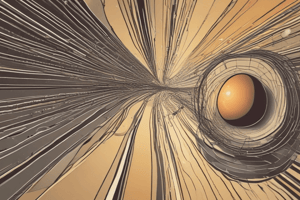Podcast
Questions and Answers
In an explosion, the gas expands outward in all directions. The force exerted by the gas on the surrounding air molecules is equal and opposite to the force the air molecules exert on the gas, causing the firework to move away from the explosion site. This is an example of Newton's ______ law.
In an explosion, the gas expands outward in all directions. The force exerted by the gas on the surrounding air molecules is equal and opposite to the force the air molecules exert on the gas, causing the firework to move away from the explosion site. This is an example of Newton's ______ law.
third
The forces acting on the two interacting objects are always ______ and opposite.
The forces acting on the two interacting objects are always ______ and opposite.
equal
In hydraulic systems, the pressure exerted by a liquid on the walls of a container is equal and opposite to the force exerted by the container on the ______.
In hydraulic systems, the pressure exerted by a liquid on the walls of a container is equal and opposite to the force exerted by the container on the ______.
liquid
If an object is stationary on a table, the upward force exerted by the table's surface is equal and opposite to the object's ______.
If an object is stationary on a table, the upward force exerted by the table's surface is equal and opposite to the object's ______.
The lifting force (thrust) exerted by an airplane's wings is equal and opposite to the _____ force exerted by the air.
The lifting force (thrust) exerted by an airplane's wings is equal and opposite to the _____ force exerted by the air.
Flashcards are hidden until you start studying
Study Notes
Newton's 3rd Law of Motion: Action and Reaction Forces
Sir Isaac Newton's third law of motion, often referred to as the "action-reaction law," is a fundamental principle that helps us understand the interactions between objects in motion. This law is essential in our quest to comprehend physics, engineering, and even everyday life.
The Law in Its Simplest Form
Newton's third law states that for every action, there is an equal and opposite reaction. In other words, when one object exerts a force on a second object, the second object exerts an equal but opposite force on the first object simultaneously. This law applies to all forces acting between two objects, whether they are stationary or in motion.
Action and Reaction Forces
The forces that result from the application of Newton's third law are known as action and reaction forces. These forces are always equal in magnitude and opposite in direction. They act simultaneously on the two interacting objects. Here are some examples to illustrate this concept:
-
A person pushing a cart: When you push a cart, it moves forward due to the force you exert. However, the cart also exerts an equal and opposite force back on you, preventing you from moving backward.
-
A boat pulling a dock: As a boat pulls a dock with a rope, the dock is exerting an equal and opposite force on the boat. This is why a boat can't move backwards when tied to a dock.
-
A firework exploding: In an explosion, the gas expands outward in all directions. The force exerted by the gas on the surrounding air molecules is equal and opposite to the force the air molecules exert on the gas, causing the firework to move away from the explosion site.
Equal and Opposite Forces
The forces acting on the two interacting objects are always equal and opposite. This equality ensures that the net force acting on an object is zero when the object is in equilibrium. For example, if an object is stationary on a table, the upward force exerted by the table's surface is equal and opposite to the object's weight. This equality allows the object to remain in a state of rest, as the net force acting on it is zero.
Applications
Newton's third law has numerous applications, from the everyday to the advanced. Some examples include:
-
Flight: The principle of reaction forces is essential in understanding the principles behind flight. For example, the lifting force (thrust) exerted by an airplane's wings is equal and opposite to the drag force exerted by the air.
-
Projectile motion: When a projectile is launched into the air, the force exerted by the ground on the projectile is equal and opposite to the force exerted by the projectile on the ground.
-
Hydraulics: In hydraulic systems, the pressure exerted by a liquid on the walls of a container is equal and opposite to the force exerted by the container on the liquid.
Conclusion
Newton's third law, stating that for every action, there is an equal and opposite reaction, is a fundamental principle that allows us to understand the interactions between objects in motion. This law is responsible for the balance in the natural world, helping us to understand everything from commonplace phenomena like the flight of birds to the complex principles behind modern engineering. By studying this law, we can better comprehend the world around us and apply this knowledge to create innovative solutions for the future.
Studying That Suits You
Use AI to generate personalized quizzes and flashcards to suit your learning preferences.




